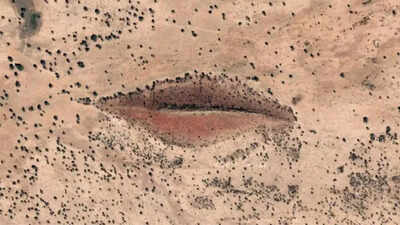
The Sudanese hill that looks just like a pair of ‘lips’ (Image source: Live Science)
A picture of a hill formation strikingly resembling human lips in Sudan was captured by a Google Earth satellite in 2012. The image appears to show a pair of human lips, giving the impression of blowing a kiss into space. Researchers have speculated about how the unusual landmark might have formed, but not much is known about it yet.According to Live Science, the striking hill, which is around 3,000 feet (900 meters) long and 1,200 feet (350 meters) across at its widest point, is located in Sudan’s West Darfur state, roughly 60 miles (95 km) east of the country’s border with Chad.
‘Landlocked Lips’: Sudan’s mysterious mouth-shaped hill captured from space
Despite its distinctive shape, the formation has not been widely studied and does not have any official name. However, based on its appearance and lack of ocean access, it has been informally labeled the “Landlocked Lips.”
The formation captured in the 2012 satellite photo appears to be surrounded by agricultural fields and dotted with small black specks, which are probably trees. The surrounding land in the photo looks parched, most likely due to drought conditions. The hill itself has a pinkish hue on its slopes, which enhances its mouth-like appearance. However, in more recent satellite images of the location, both the hill and its surroundings appear much greener and are covered with significantly more vegetation. This change may suggest seasonal variation or recovery from drought, further emphasizing how dynamic the region’s landscape can be.
Geologists say, the unusual landscape may be ancient Dikes
According to reports, Josh Roering, a geomorphologist at the University of Oregon, says that the unusual formation resembles a dike. He explained, “It looks like there’s a dike or narrow unit of resistant rock running through the middle of that ridgeline that erodes more slowly than the surrounding rock and thus sticks out.”Dikes are geological features that cut across larger horizontal sheets of rock, according to the European Geosciences Union. They are most commonly formed via volcanic activity or tectonic plate movements. In some cases, they can also form as a result of sedimentary processes. These formations tend to be more resistant to erosion than the surrounding rock, which is why they often appear as elevated ridges on the landscape. However, it is unclear what type of dike this hill’s central line may be.Similar structures can be found in the other parts of the world, such as the New Mexico desert and the Mackenzie dike swarm in Yukon, Canada. These global comparisons could offer clues to the origin of Sudan’s “Landlocked Lips,” but for now, the mysterious hill remains an intriguing natural feature awaiting further study.

 8 hours ago
42
8 hours ago
42




























 English (US)
English (US)